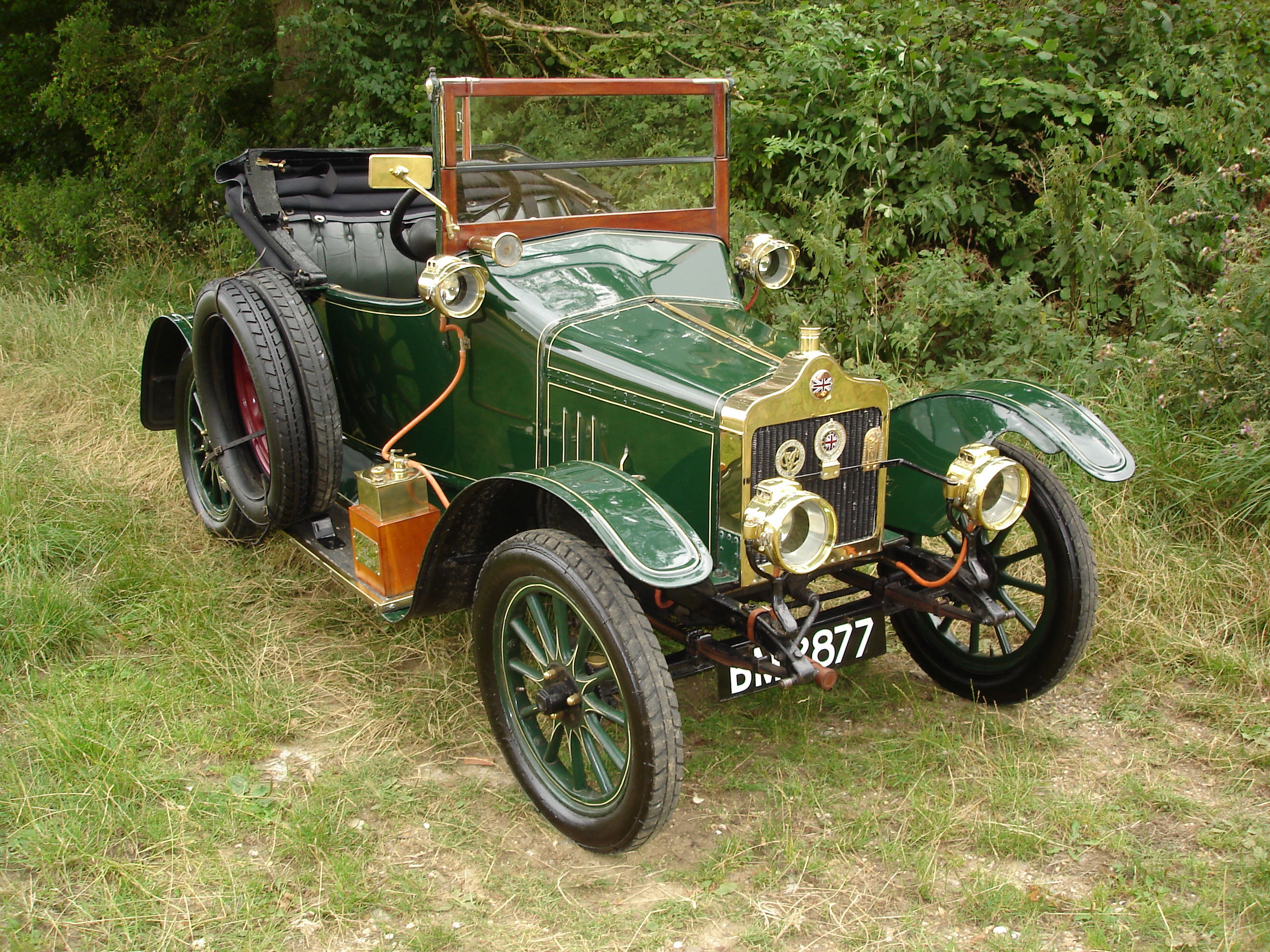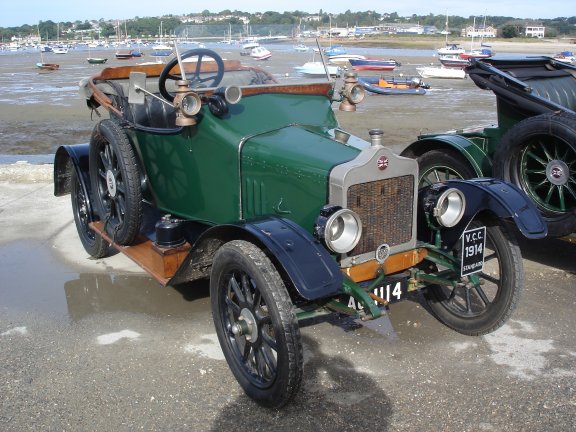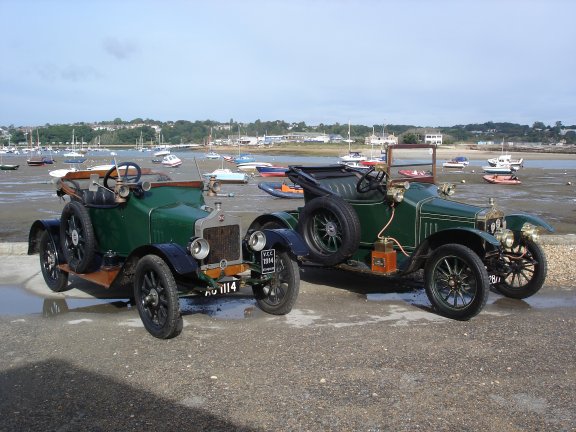|
|
|
Standard Model 'S' (1913 - 1918)
|
Standard's first entry into the Light Car Market and introduction to Mass Production  THE
‘ALL-BRITISH’ STANDARD LIGHT CAR
The ‘Light Car’ vogue began late in 1912, and
the 10 h.p. Morris Oxford and the 10 h.p. Singer were already on the market when the Standard Model ‘S’ 9.5 h.p.
‘All British’ Light car was first mentioned in the ‘Autocar’ on March 1st, 1913.
The Morris had the 60 x 90 m/m White and Poppe four cylinder engine with the engine, clutch and gearbox in unit, and
such was the rush to show the car at the 1912 Motor Show that a wooden dummy engine was installed and deliveries did not commence
until March 1913. The Singer Light Car went to the other extreme and the gearbox and final drive on this
popular model were in unit, but this resulted in an abundance of unsprung weight at the rear.
The Model ‘S’ was advertised to be available for
May 1913 delivery at £185, with a three-year guarantee. R.W. Maundslay the founder of the Standard
Motor Company had instructed his designers to follow established practice and they did not try to evade the facts.
Although termed a ‘light car’,
they realised that the occupants of the vehicle would not necessarily be small or light and so a commodious two-seater body
was evolved. Secondly, they considered that if the car was small and handy to drive, it would be put to
constant work and therefore durability and freedom from trouble were to be prime considerations. So it
was decided that the Model ‘S’ should embody large car practice on a miniature scale at a proportionate price.
The full specification of the model ‘S’ was as follows: -
ENGINE:
4-cylinder 62m/m bore x 90 m/m stroke; monobloc casting.
VALVES:
All on one side and enclosed
LUBRICATION:
Automatic, oil being circulated by a pump driven off camshaft and returned to a large sump.
R.A.C. RATING:
9.5 horse power.
CARBURETTOR:
Zenith
IGNITION:
High tension
magneto – variable spark
COOLING:
Thermo siphon;
large radiator; fan.
CLUTCH:
Single disc type, a metal driving plate engaging with asbestos covered surface on flywheel
GEARBOX:
Centrally mounted, three speeds forward and one reverse; gate change.
FOOT BRAKE:
At rear of gear box; external shoes and renewable Ferodo liners
REAR BRAKE:
Internal expanding shoes renewable
CHASSIS:
Pressed steel frame
REAR AXLE:
Overhead worm; ball bearings throughout
FRONT AXLE:
‘H’ section stamping; ball bearings to front hubs and steering swivels
WHEELS:
Detachable steel 700 x 80 m/m
WHEELBASE:
7 ft 6ins.
TRACK:
4 feet
GROUND CLEARANCE:
9 ½ ins.
BODY:
‘Rhyl’ 2 seater body with high side doors and scuttle, hood, screen, horn, five lamps, spare wheel and
tyre, full set of tools and replacements.
DICKEY SEAT:
Can be fitted at extra charge of £3.
In April , 1913 ‘The
Motor’ were permitted ‘the pleasure of a run on this car’ and found that ‘the car runs as quietly
as a large car, the engine being exceptionally silent, and there is absolutely no vibration felt from it even at high speeds’.
No doubt this report on the new car stimulated interest
from would-be purchasers, but at the end of May, 1913, the advertisements read ‘for delivery in August’, so the
Morris Oxford had a clear six months lead and by now competition for the market in the under £200 class had to be faced
from Swift, Calcott, Hillman, Turner, A.C., Salmon, Knight and Lagonda, all of whom, with others, were
entering the ‘light car’ market.
Fortunately, Maundslay had seen that the potential demand for his little car was there
for the taking if he could build enough of his new light cars at the right price, British Business Motors
limited went into voluntary liquidation early in 1913 and their Cunard Motor Works at Coventry (at Widdrington Road, Coventry,
with a long frontage to the Coventry Canal) was put under the hammer by Knight, Frank and Rutley on the 1st May
and became one of the Standard Motor Company’s factories where production of the Model ‘S’ was concentrated.
By August 1913, the first customers were beginning
to receive their long awaited cars, but the price of £185 remained only until September 30th, when it was
increased to £195 the same price as the Morris Oxford. Production of the Model ‘S’ went
forward steadily during the winter of 1913/14 and quite a number of the cars went abroad, notably to India and South Africa.
The 1914 Siddeley Cup held by the Royal Automobile Club of South Africa took the form of a trial from Maitland to Caledon.
The winning car was a 9.5 h.p. Standard driven by R. Goldberg, carrying two other occupants including an R.A.C. official
observer who officially recorded the petrol consumption at a phenomenal 50.7 miles per gallon!
At home, using Dunlop tyres and Lodge Plugs the sole Standard
Model ‘S’ in the R.A.C. Light Car trial could only manage 31.41 m.p.g. Against the winning Singer’s 35.74,
but it covered the 1,000 miles non-stop and gained a gold medal for its performance – only eight cars finished out of
32 starters. Later the same month (May 1914) three Standard Light Cars headed their class in the Irish
Automobile Club’s Trial and the organisers decided to award a special prize to the entrants of the Standard cars for
their remarkably consistent running.
The first Model ‘S’ Standard’s can be easily distinguished from the later models by the radiators which
until July 1914 had panelled sides, but with the introduction of other coachwork on the 9.5 h.p. chassis, the open sided radiator,
which was to last until the late ‘twenties’, made its appearance. The basic ‘Rhyl’
2-seater continued at £195 and was joined by the ‘Rhyl’ Special All-Weather 2-seater at £210 which
boasted a superior cape hood, side screens and a two-piece windscreen – Standard’s pioneered all-weather equipment.
In a more sophisticated vain, the buyer could choose from ‘Hurlingham’ Victoria £250, ‘Ranalagh’
Coupe or ‘Richmond’ fixed head coupe, both £275, coachwork, which had been shown at Olympia in November
1913, but which only just going into serious production. Or, if, as the Standard advertisement in
the August 1914 ‘Autocar’ proclaimed ‘your horses are commandeered – have a Light Van’ you could
choose from the Canvas Top model at £185 or the tradesman’s High Van at £205. All were
now available with 12 volt electric lighting at an extra 15 guineas.
Such was the demand for the car that a large marquee was erected alongside the canal at Widdrington
Road factory while extensions to the works were carried out, but it is doubtful whether these extensions were used for the
production of the Model ‘S’ because in the winter of 1914/15 most of the British Motor Industry was turning over
to the production of war material and by April 1915 it was estimated that 80% of the output of most car makers was devoted
to munitions. Other, larger, Standard cars had been made up to the end of 1914, but only the Model ‘S’
continued into 1915 and last advertisements for the 9.5 h.p. car appeared in May of that year.
In a period of less than
two years, the Model ‘S’ had proved economical to run and trouble free and the public believed that the policy
of putting value into a car of straightforward design had paid dividends. The Company had just reason to
be satisfied with the little car and endorsed this by re-introducing it, briefly, in 1918, when a further 198 chassis were
manufactured. It was replaced by the Model ‘SLS’ (LS = long stroke) an improved version,
which provided economical motoring for the many service personnel who had learned to drive during the Great War, but this
is another story.Written by the late John Davy and first published in Veteran
and Vintage magazine in 1966. Total production was 1,936 up until May 1915 with a futher batch
of 198 late in 1918/early 1919. There are 18 known survivors world-wide.
|
 |
|
|
 |
|
 |
|
I recently took my 1913 example to the Isle of Wight, and whilst on the Island, took the opportunity to visit a 1914
example that lives on the Island. The current owners father, retired to the Island in 1974 and took the car with
him. In 1974 they drove their Rhyl from Nottingham to the Isle of Wight, and travelled down the M1 motorway (not
something that I would like to undertake today)

|
| 1914 Rhyl |
 |
 |

|
| 1913 and 1914 examples parked in Bembridge Harbour, Isle of Wight. |
 |
|
|